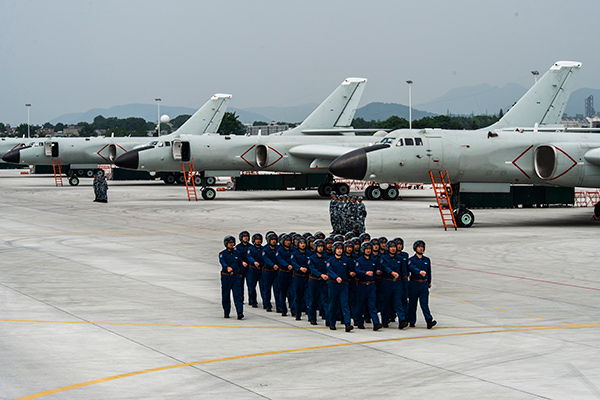Long-range bomber may be in China's plans
Updated: 2015-07-07 08:15
By Zhao Lei(China Daily)
|
|||||||||||
 |
| 图片说明 |
A series of articles in the magazine's June issue analyzed Chinese bombers' performance and called for the development of a long-range stealth bomber, probably representing a collective notion among industry insiders that China should start designing a long-range strategic bomber as soon as possible.
"A medium-range bomber can't essentially fix the PLA air force's shortcomings in terms of strategic strike and strategic deterrence. ... Thus the air force does need an intercontinental strategic bomber capable of penetrating an enemy's air defenses," one article said.
Unanimous appeal
The petition for a mighty bomber is not new. Chinese military experts have urged the government for at least two years to seek a replacement for the Cold War-era H-6 aircraft.
Wu Guohui, a military equipment researcher at PLA National Defense University, said in October 2013 that large bombers were once ignored by air powers because they were deemed as having poor survivability. However, the United States, Russia and China have acknowledged the advantages of stealth bombers. They can carry out nuclear strikes as well as long-distance precision bombing by conventional weapons, and can be used repeatedly, meaning they are more cost-efficient and agile than a non-reusable ground-to-ground missile.
"The US has decided to invest $1.2 billion every year to develop its second-generation long-range stealth bomber based on its Northrop Grumman B-2 Spirit, while Russia is upgrading its current bombers and developing a new stealth bomber," he said. "China still lags behind in this field, so we should develop our own long-range bomber."
Despite some foreign military analysts' assessment of China as one of the three air powers after the US and Russia that still maintain strategic bombers, the PLA air force must be fully aware that its bomber fleet is much weaker compared with its counterparts in the US and Russia, because it only has an unknown number of H-6 bombers, which are based on the Soviet-era Tu-16 Badger, designed in the 1950s and retired by Russia in the early 1990s, military observers said.
The US Strategic Command now has the Boeing B-52, the Rockwell B-1 and the super-powerful Northrop Grumman B-2, while Russia's Long Range Aviation Command owns the Tupolev Tu-160, Tu-95 and T-22M.
According to Western aviation sources, Aviation Industry Corp of China has continued to upgrade the H-6 with the latest avionics equipment and new materials, and has developed a family of variants that can conduct various tasks, including aerial refueling and reconnaissance. However, the aircraft's antiquated structure, together with old engines, leaves it incapable of performing long-range operations or flying deep into enemy territory to deploy ordnance.
Today's Top News
Country's cold remedy enters the UK market
Post-Greece, Germany and EU face reality
Greece enters uncharted territory after 'no' vote
Govt scrambles to halt market slide
Chinese visitors in Turkey on alert
Social media blamed for huge rise in the number of divorces
Power Link generates momentum with UK base
Russians will 'surprise' in victory parade: Ambassador
Hot Topics
Lunar probe , China growth forecasts, Emission rules get tougher, China seen through 'colored lens', International board,
Editor's Picks

|

|

|

|

|

|






